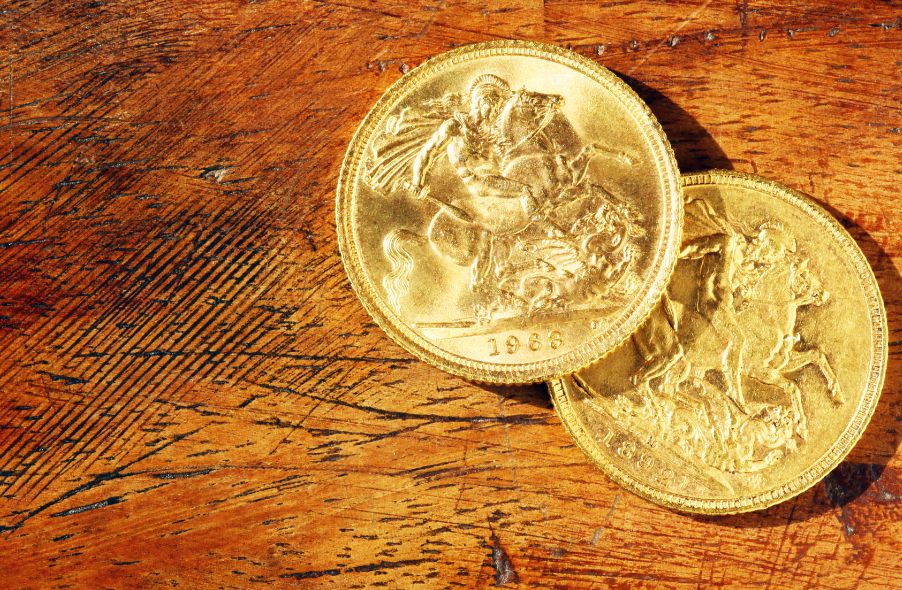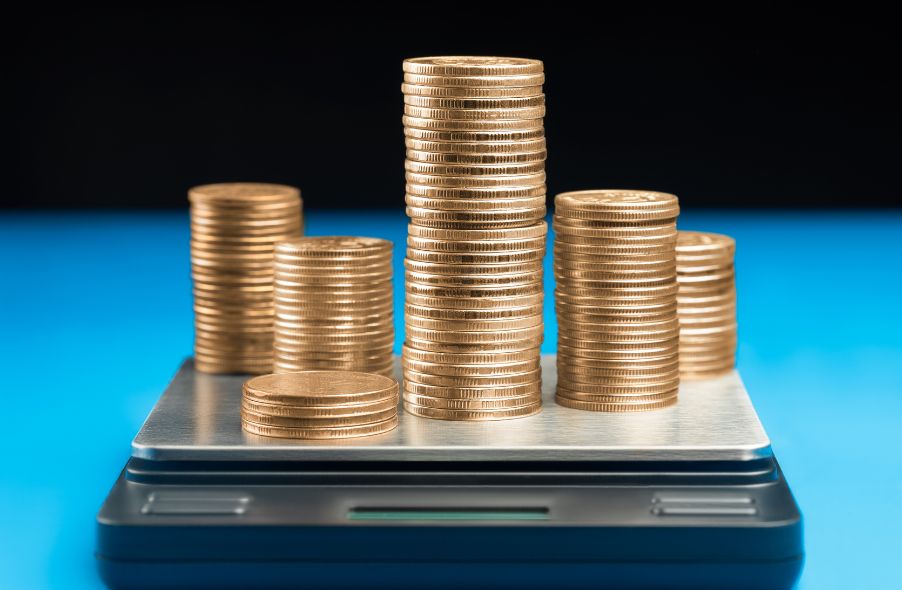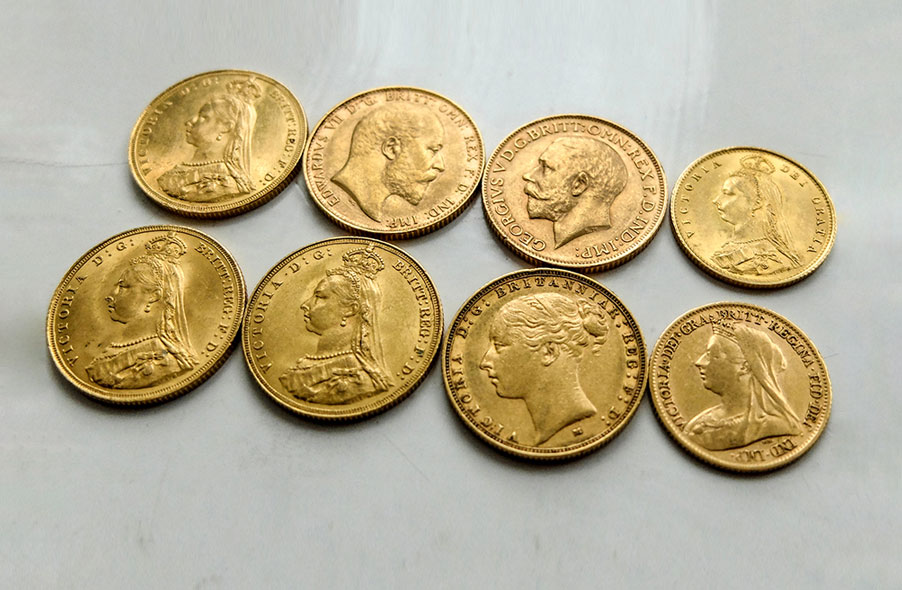One of the most enjoyable aspects of investing in gold is choosing unique gold coins to add to your collection. Gold sovereign coins have a rich history that attracts many investors. But what is a gold sovereign, and should you invest in these coins?
Here’s everything you need to know about gold sovereign coins.
What Is a Gold Sovereign?
A gold sovereign is a gold coin issued by the British Royal Mint. These coins were British currency for some time, each with a face value of £1. While they are no longer in circulation, gold sovereign coins are popular investment items and collectibles.
The gold sovereign is one of the most liquid gold coins in the world, as there is an extensive market for its numerous designs and varieties. Because each gold sovereign has a gold content of approximately 0.2354 troy ounces, these coins have inherent value on top of their numismatic value.
The gold sovereign is now considered a bullion coin because it is not an accepted currency. Many investors have incorporated gold sovereign coins into their investment strategies for decades, and these coins are widely regarded as safe, stable methods of diversifying one’s investment portfolio.
What Is a Gold Proof Sovereign?
A gold proof sovereign is a type of gold sovereign coin with a hand-polished, high-quality finish. These coins have a mirror-like appearance that leads some investors to pay more for them than standard sovereign coins.
History and Popularity

Gold sovereign coins date all the way back to 1489, during the reign of Henry VII. The king wanted to produce “a new money of gold,” so the Royal Mint created a coin that depicted his portrait on the front side. The reverse featured a double rose, signifying the union between York and Lancaster.
This first gold sovereign coin set the trend for future monarchs to strike new versions depicting their own portraits, a practice that continued until 1603. Then, after the Battle of Waterloo in 1815, authorities created a new 20-shilling coin under the previous sovereign name.
This coin was about half as wide and heavy as the original coin and featured an image of St. George and the dragon. In 1817, the gold sovereign officially became a circulating coin accepted in Britain and many other parts of the world.
New iterations of the gold sovereign continually reflected memorable historical periods, such as Queen Victoria’s reign. The gold sovereign continued circulating until 1914, when a surge in gold buyers depleted the Bank of England’s reserves. At this point, the British government began circulating one-pound and ten-shilling banknotes instead of the sovereign and half-sovereign gold coins.
The gold sovereign became a trade coin at this point, and in 1979, the Royal Mint began striking the gold sovereign specifically for the bullion market. New designs featuring Queen Elizabeth came out regularly. After Queen Elizabeth’s death, the Royal Mint issued new sovereigns featuring the bust of King Charles III.
Design and Minting
While the gold sovereign is a British coin, the Royal Mint isn’t the only manufacturer. Between 1917 and 1957, other mints across Canada, South Africa, and Australia also produced this coin.
Then, the Royal Mint became the sole producer until 2013, when it struck a deal with an Indian company to share the mintage of these coins. Still, you can be sure that gold sovereigns minted in other countries are of the same quality as those minted in the U.K.
Though numerous designs have been depicted over the centuries since its origin, one major designer stands out in the coin’s history: Benedetto Pistrucci.
What is a gold sovereign coin’s defining feature? The most common iteration of the gold sovereign features a reverse image of St. George and the dragon designed by Pistrucci. This design has appeared on the sovereigns for every monarch since Queen Victoria. In 1893, it also began appearing on the half-sovereign coin.
Gold Content and Weight

The gold content of sovereign coins has varied over the years. Today, the standard gold content is 7.323 grams, equal to 0.2354 troy ounces. This gold content gives the sovereign coins a purity of 0.9167, with the other 1/12 of the coin consisting of copper.
However, historical versions of the gold sovereign have featured different weights and gold contents. For example, Henry VII’s first version contained 0.5 troy ounces and weighed 15.55 grams.
In the mid-19th century, authorities realized that some sovereign coins became lighter over time because of gold’s softness. The weight of the sovereigns at this time was supposed to be 123.274 grains, equivalent to almost eight grams. Authorities determined that any coins weighing less than 122.5 grains ceased to be legal currency.
Taxation and Exemptions
U.K. residents can enjoy tax exemptions when liquidating gold sovereign coins. These coins are not subject to capital gains taxes in the U.K., allowing sellers to keep 100% of the profits they earn from liquidation. This same rule applies to any gold coins the Royal Mint produces as legal tender, and it’s applicable no matter the volume or value of the sales.
If you live in the U.K., this tax exemption may make investing in gold sovereigns highly lucrative compared to other gold investments. For reference, the typical capital gains tax rate on gold is 28%.
Meanwhile, if you live in the U.S., you may be able to purchase gold sovereign coins without paying any sales tax. Different states have different policies about taxing coins and precious metal bullion.
Investment and Diversification

Investing in gold sovereign coins could be a fun way to diversify your investment portfolio. On its own, gold acts as a reliable hedge against inflation, as the value of gold tends to increase when the value of the dollar decreases. It’s also a highly liquid asset, and you can sell it through a range of online and in-person methods.
But purchasing gold in a collectible form, such as a gold sovereign coin, gives it even more value beyond its gold content. Collectors pay good money for gold sovereign coins simply to add them to their collections. When you’re ready to sell, you should have no problem finding an interested buyer.
What Is a Gold Sovereign Worth?
You can calculate the base value of a gold sovereign coin by multiplying its weight in troy ounces by the spot price of gold.
The spot price varies on a day-to-day basis, but in 2023, it will have averaged around $1,844 per troy ounce. A standard gold sovereign coin is 0.2354 troy ounces, making the average value around $434 for one coin.
Older and rarer gold sovereign coins may sell for more than newer varieties. The best way to determine how much a specific gold sovereign coin is worth is to look at other sellers’ prices. Doing your research in this regard can go a long way in ensuring you properly value your investments, whether in anticipation of a purchase or sale or simply for your edification.
Final Thoughts
Now that you know the answer to “What is a gold sovereign coin?” you can decide whether this gold product is right for your investment portfolio. To learn more about investing in physical gold or a gold IRA, check out the Learn About Gold blog.





